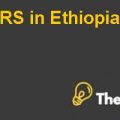
Question 4
Answer 4
If the company Talbot wants to choose the method of previous GAAP adopted, then the goodwill would be amortized for 40 years. The basic calculation for the good will amortization is the actual cost of 2007 which is divided by number of years. In the number is shown like this $ 247,490,000/40 which will give the result of $6,187,250. All these calculations are shown in the excel file.
Question 5
Answer 5
Comparison of the Estimation
This analysis is particularly made in the light of the effects of change in amortization and impairment to income statement. According to the standards, there are insignificant effects of amortization up till 2008 because such changes according to FASB, are not even significant to portray a significant effect on statements. And secondly, the loss incurred by enterprise is not because of inappropriate amortization rather it is due to the heavy cost of sold by the enterprise. Furthermore an impairment has significant effects on the results because of a significant change in the fair value of measurement. The effects are hereon dealt on two different headings.
Effects with Changes Amortization
In the “Appendix E,” one side is showing the effects of changes with amortization and impairment of the goodwill and other intangible assets. This will have an adverse effect on the earnings of enterprise with the inclusion of amortization expense during 2007 & 2008. However, it is beneficial to some extent for the tax purpose which is 37% on average calculation. In addition to the case scenario goodwill will be reduced by the impairment and further move in the year of the balance sheet. Every year the impairment will be tested and curtails the extra cost with the effects of the reduction in the net income.
Effects without the impairment and amortizations
Effect without the impairment and amortization cost is shown in the “Appendix E” on the left side. Again the same impact curtails with the reduction in the loss side, but still loss is remaining. This effect is only reduced to the calculations of the cash flow because the impairment cost is the non-cash item and it is not included in the cash items. These criterions are defined by accounting bodies across the world, GAAP in particular as the fact is, accounting operates on accrual basis. Therefore impairment should be tested for every year under the concept of prudence.
Question 6
If the enterprise recognized it half of its goodwill and rest go to the fixed assets, parts then the effect will turn around. This is reflected in the increase in the depreciation cost and decrease in the impairment cost. Also decrease in the losses of the net income and the benefit of the Taxes will also reduce with the reduction in the losses. Furthermore, it will also impact in the previous acquisition of the entity and their criteria. These are the key factors which could have been the cause of changing goodwill recognition and allocation.
Question: 7
Opinion
As all the fair value adjustments, goodwill measurement, and amortization & impairment effects are done with respect to FASB and GAAP. Further the opinion for the unverifiable fair values will improve the usefulness of the financial reporting because those are the key highlights for making notes to the financial statements and other part of assets for justifying the values of the reporting. Yes, these things are important in management’s prospect because they may an easy way out to comply reporting norms and obligations. Thus it also gives a judgmental eye to the shareholders that may help in exchange of value..................................
This is just a sample partial case solution. Please place the order on the website to order your own originally done case solution.













